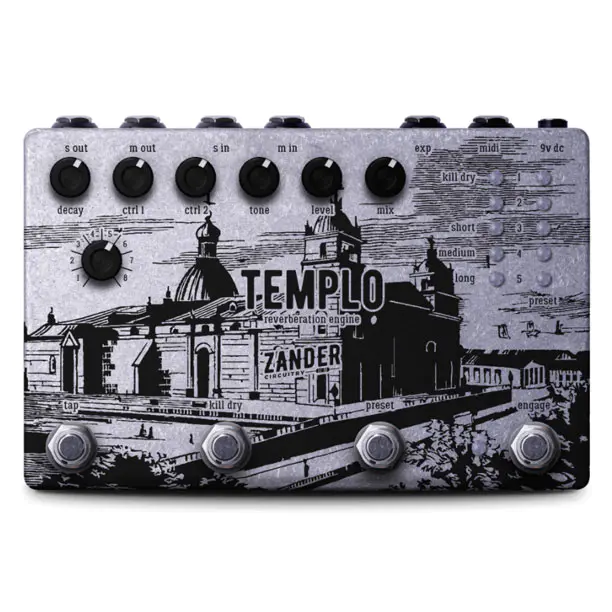
Alex Millar at Zander Circuitry is one of the few really boutique builders releasing full-fledged multi-mode pedals in this day and age, and the Templo is his take on the fully stereo multiverb workstation.
The pedal’s eight modes offer algorithms ranging from the traditional (Spring/Tile, Room/Hall) to the modulated ambient (Cave, Whirl), but it’s pretty obvious that what this pedal specializes in is “the weird stuff” from the remaining four selections:
- a Spectral mode that produces a large church style reverb combined with a lower octave duplication as well as a higher octave shimmer effect.
- a Solid State mode based on the uniquely strange effect you get when you attempt to use a BBD device for a reverb
- a Lo-Fi mode delivering shorter/thinner reverb with a high pass filtering & sharper modulation simulating degraded tape.
- a Granular mode that sounds dissonant and artifact-filled and it’s combined with a bitcrushing/aliaser effect for extra insanity.
Of the 6 knobs, Decay, Tone, Mix and Level do exactly the same thing in any mode, while the two Ctrl modes affect varying parameters depending on the selected mode.
The Zander Templo features also a very unique tap feature that allows you quickly switch between short, medium and long decay times, while the other footswitches deal with preset navigation (up to 5 can be stored), kill dry switch, and a momentary max decay effect.
Other standard features include full expression pedal control and Midi compatibility.
Here are the intro videos os the Zander Templo, you can explore videos for each mode by clicking on the links in the description above. We added this pedal to our article about the best multi-reverb pedals.
Zander Templo, Builder’s Notes
The reverberation engine
Bow in reverence and awe at the temple of reverb. The Templo is our multi-reverb that perfectly walks the line between the familiar and the unknown. From the humble twang of a spring to the vast expanses of chasms and caves, you’re sure to find a multitude of uses for adding a bit (or a lot) of space and depth to your sound.Reverb, in our opinion, is one of the most essential effects for any instrument, whether its adding a splash of room to make your sound more ‘present’ or masses of shimmery octave to create a glistening soundscape, its the only effect that many people almost always have on. The Templo is home to eight unique modes, four that are more traditional and four that are quite experimental.
As well as the self-explanatory Decay, Tone, Mix and Level knobs, the Templo has two CTRL knobs that alter distinctive additional parameters for each of the eight modes, giving you even more flexibility to sculpt the perfect reverb sound for your needs. (It’s also MIDI-compatible, so you can expand your horizons to 128 presets with a MIDI controller.)
It doesn’t stop there though, the Templo is also loaded with secondary functionality such as 5 on-board presets, a kill dry switch, momentary max decay capability, full expression pedal control and a very unique tap feature that allows you quckly switch between short, medium and long decay times.
The Templo’s eight modes are:
- Spring/tile: Voiced around the various spring reverb tanks used in countless classic amps, shorter decay and delay times offer a very sharp and reflective sound we call ‘tile’ (think playing in a large bathroom). CTRL 1 lets you extend the pre delay time to emulate a larger spring tank, CTRL 2 alters the short delay time which adds more ‘springiness’ to the sound.
- Room/hall: A flexible ‘all-rounder’ reverb that offers room (short decay/pre delay) and hall (long decay/pre delay) sounds. CTRL 1 alters the predelay and CTRL 2 affects the low frequency loss.
- Cave: A deep, dark verb capable of long decay times combined with a wide-ranging modulation section. CTRL 1 & 2 control the modulation rate and depth respectively.
- Solid State: Based around the delay time structure of the MN3011 bucket brigade delay chip that was used in many analog/solid state verb units. CTRL 1 alters the main delay time that the other delay taps centre around, CTRL 2 offers a diffusion/dampening control to make the delay reflections less obvious.
- Whirl: A large church style reverb combined with a four voice chorus. CTRL 1 & 2 control the modulation rate and depth respectively.
- Spectral: A large church style reverb combined with a lower octave duplication as well as a higher octave shimmer effect. CTRL 1 is the lower octave mix, CTRL 2 is the higher octave shimmer mix/intensity.
- Lo-Fi: A shorter/thinner reverb with very intense high pass filtering & sharper sounding modulation. CTRL 1 controls the modulation speed, CTRL 2 alters the frequency of a 2 pole high pass filter.
- Granular: A dissonant, artifact-filled verb combined with a bitcrushing/aliaser effect. On this patch the decay control can also mix out the reverb, leaving just the bitcrusher/aliaser. CTRL 1 is the aliaser frequency, CTRL is the aliaser mix.
The Templo’s seven dials:
- Decay: Reverb time (max decay varies across patches)
- CTRL 1: Additional parameter
- CTRL 2: Additional parameter
- Tone: EQ for the wet signal
- Level: Output volume
- Mix: Blend control (from 100% wet to 100% dry)
- 1-8: Effect selector
Plus, it has four footswitches:
- Engage: Turn it on and off
- Kill dry: Removes the dry signal, has both a momentary and latching mode.
- Preset: Access your favourite sounds
- Tap: Quickly tap between short and long decay times, hold down for max decay time.
Not to mention:
- Top-mounted in/out jacks (with full stereo options)
- Expression pedal input
- MIDI input
- Power requirements: 9V DC (center-negative) supply
- Current draw: 250 mA
Dimensions:
- (W)180 mm x (L)120 mm x (H)55 mm






















